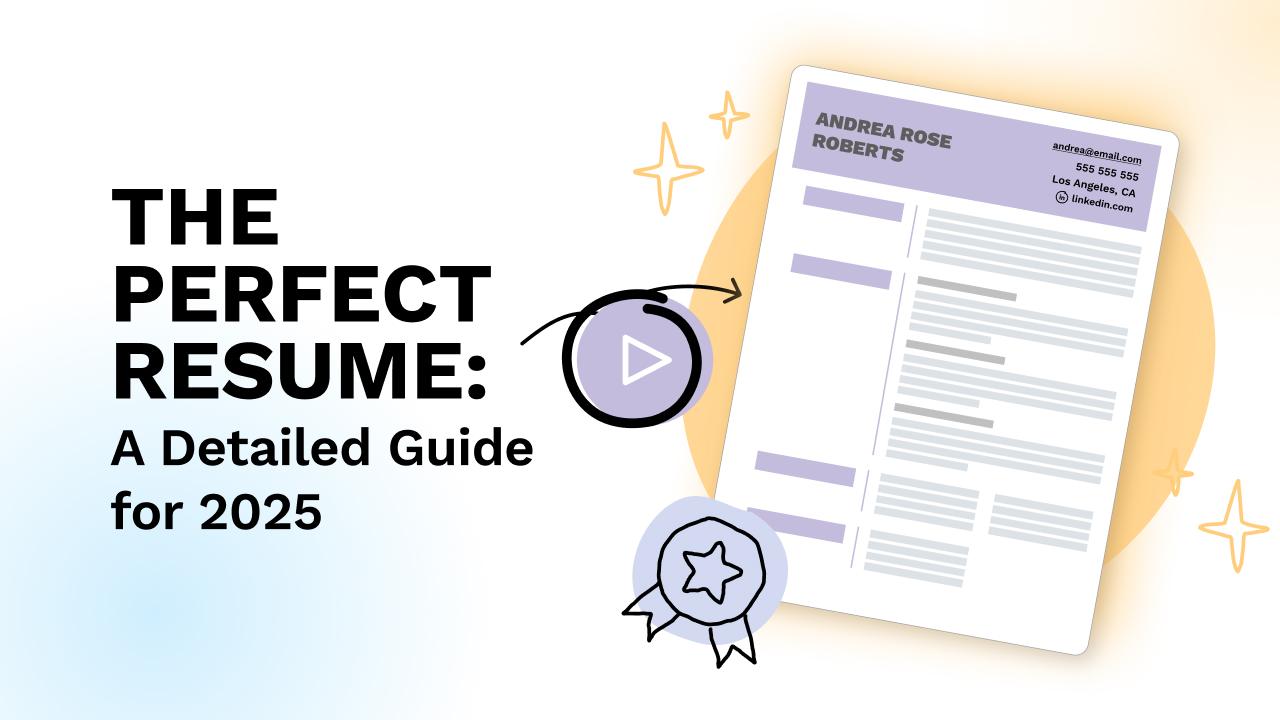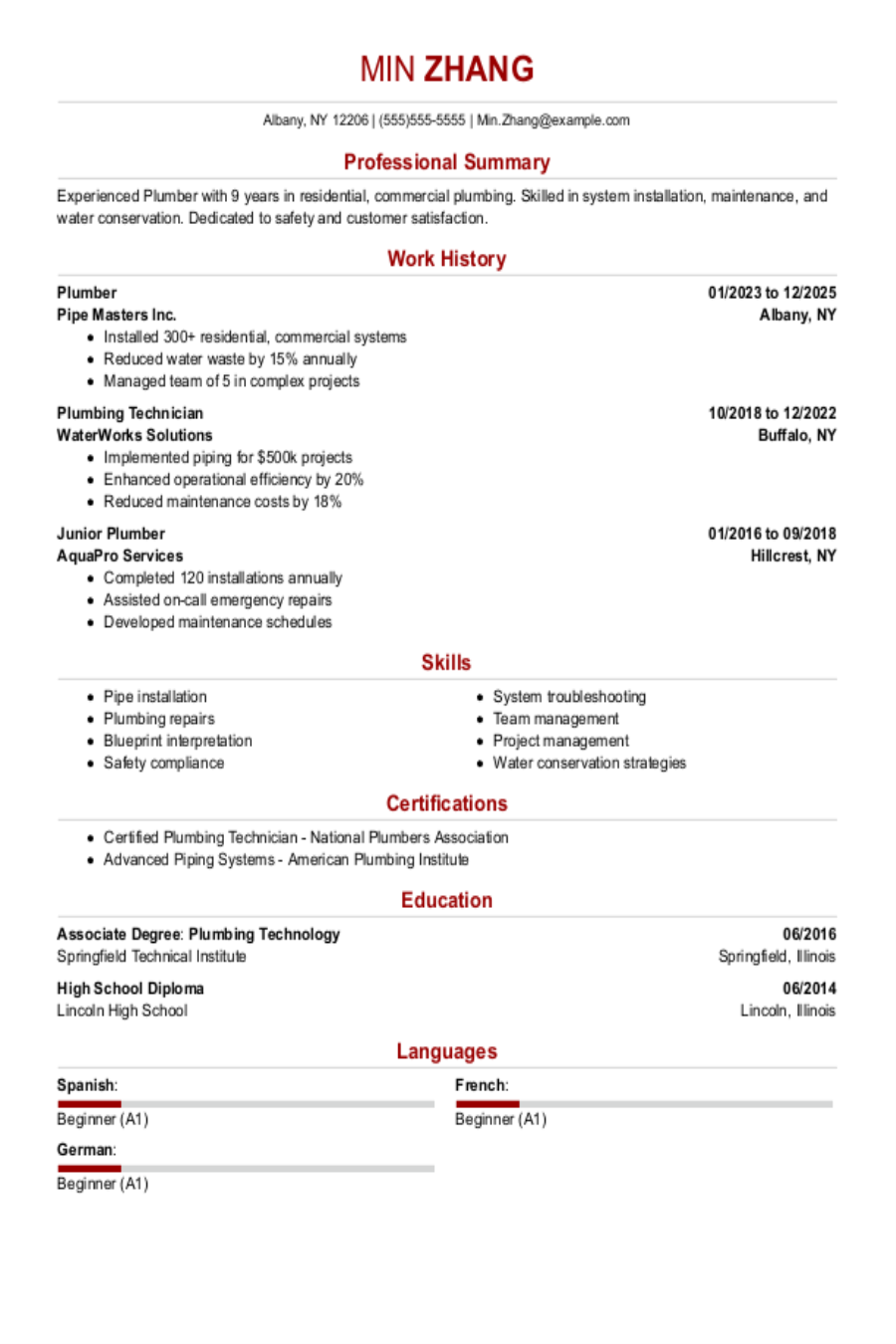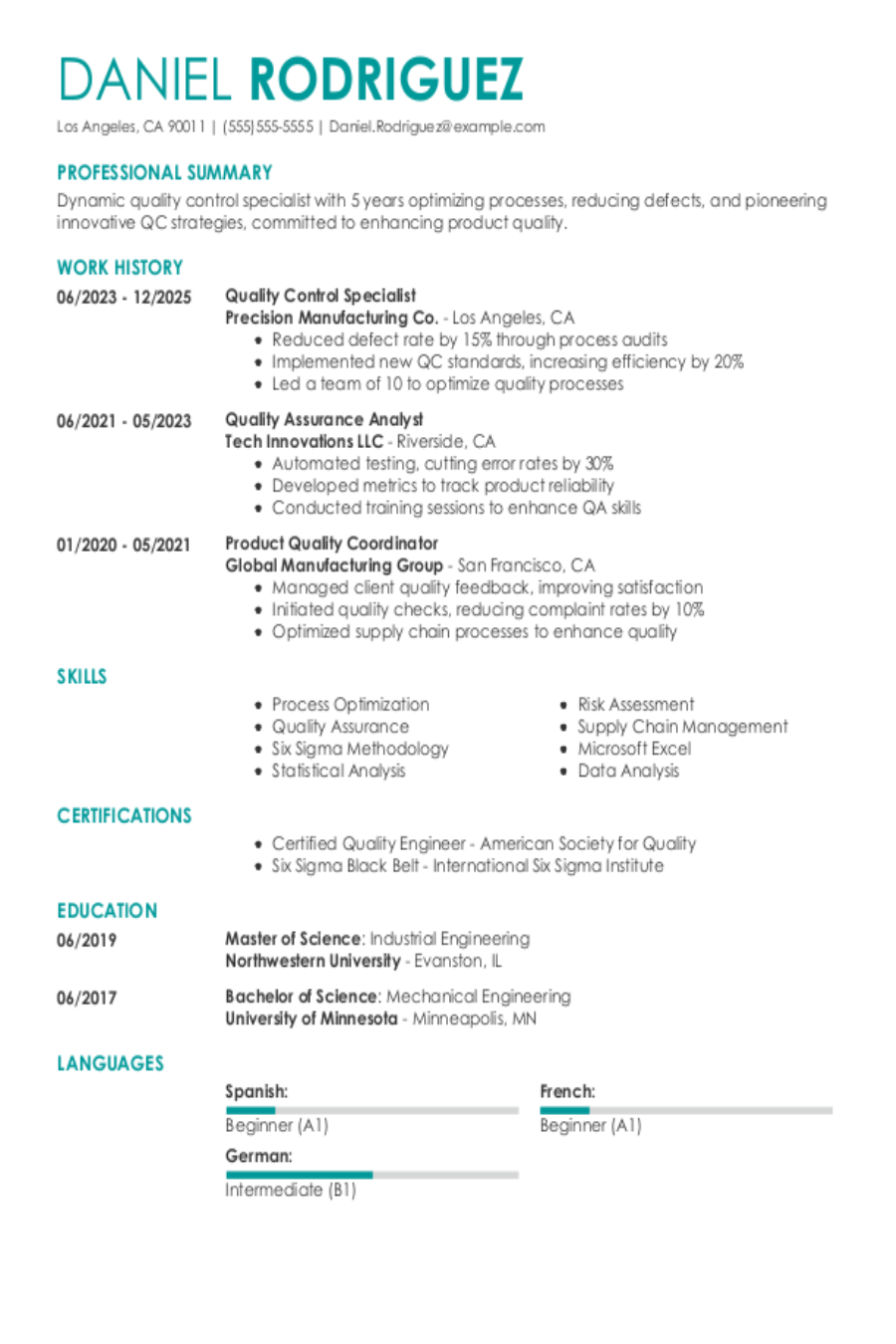Writing a resume that stands out to employers means asking and answering lots of important questions about who you are as a professional and what employers are looking for. But what can you do to take a resume from thoughtful to perfect? View our guide with samples and tips to create the perfect resume for your 2025 job search.
This perfect resume guide will show you:
- What a perfect resume looks like
- Perfect resume templates in popular styles
- How to choose the perfect resume format
- How to write a perfect resume in five steps
Ready to create the perfect resume? Try our AI Resume Builder. This tool offers AI-powered resume writing assistance, stylish, ready-to-use resume templates, and step-by-step guidance that walks you through the process of creating a job-winning resume.

Perfect Resume Example
The perfect resume is more attainable than you might think. It begins with mastering the basic parts of a resume. Focus on the following core sections:
- Contact information
- Professional summary or resume objective
- Work history
- Skills
- Education credentials
Beyond these basic sections, your resume may include additional optional sections. The perfect resume emphasizes the strong points of your career, including experiences that don’t fit into the traditional resume mold.
Some candidates would benefit from adding professional associations, volunteering, foreign languages, or special projects, to name a few. The final list will depend on each job seeker’s situation.
Now let’s see what the five primary sections look like when arranged in a perfect resume layout.
Why Is This a Perfect Resume?
This resume is perfect because:
- It includes the five key sections: header with contact info, professional summary, work experience, skills, and education.
- The design is visually appealing.
- The design is also ATS-friendly, meaning it will bypass employer screening software.
- Career achievements are neatly laid out in a professional summary.
- A range of both hard and soft skills are displayed throughout the resume’s sections.
- Education and credentials are highlighted.
Next, we’ll show you how you can make the perfect resume.
How You Can Make the Perfect Resume
Visualizing a resume is one thing, but how do you write a perfect resume?
You have to write a resume that speaks to your accomplishments, experience, and skills and gives the hiring manager a reason to call you back. Once you’ve settled on a resume outline for the resume sections you’ll include, it’s time to write your resume.
Following these steps will help you perfect your resume and provide a real advantage over other job seekers.
STEP 1
Write a professional summary
Your resume summary is a chance to encapsulate your career. Professional summaries are a type of resume profile that is typically two to four sentences long and they speak to the accomplishments and skills that make you a good fit for the role.
Let’s see what a perfect summary looks like.
Professional summary example
Dedicated and skilled line cook with three years of experience preparing food and serving customers for fine dining restaurants. Track record of completing orders quickly and efficiently, and known for being reliable and collaborative. Trained in OSHA’s food safety standards.
This example is perfect because it:
- Opens with candidate-defining skills
- Mentions role and level of experience
- Shares achievements that address the employer’s bottom line
- Touches on desirable personality traits
- Highlights qualifying training
Summaries should always be concise and to the point, giving the employer a snapshot of who they’d be hiring. The bottom line is, you want to show you are qualified and driven to succeed.
For some candidates, an alternative option for a resume profile may work better. Early career candidates may benefit from a resume objective instead of a professional summary. Read our guide on resume objectives to see many examples and decide if this is a better option for you.
STEP 2
Craft the perfect work experience section
On most resumes, job history should take center stage. After all, experience is a job seeker’s best evidence that their skill set is valuable in the real world.
When perfecting your work history, there are two important pieces of advice to keep top of mind:
- Use bullet points to list your experience.
- Customize the wording to match the job listing.
Bullet points will make your resume more readable and help the reader grasp your experience at a glance. Each bullet should highlight an accomplishment or unique skill. Include quantifiable results whenever possible.
Then, when you have a solid list of workplace achievements, tweak the wording to match the job description. If the description mentions “effective communication,” your experience should include a line on how you “effectively communicated” during a specific task or project.
STEP 3
List your hard and soft skills
You don’t want to leave any relevant skills off your resume. Comb through the job description to determine which skills are most important to the employer and most likely to show how well you fit the role.
Match those skills to your work history, and make sure they are included in your resume. Anything you couldn’t work into your work experience or professional summary would be a perfect candidate to list in this section.
A perfect resume includes a mix of hard skills and soft skills. Hard skills are the technical abilities that you’ve learned through education, training, or practical experience. Soft skills are the interpersonal strengths that enable you to effectively interact, collaborate, and thrive in a workplace environment.
While skills are specific to the job, there are some that transcend boundaries and would be wise to consider adding to your resume to improve your chances.
Hard skills found on a perfect resume:
Recordkeeping
Microsoft Office
Adobe Creative Suite
Data analysis
Design
Project management
Soft skills found on a perfect resume:
Teamwork
Leadership
Communication
Creativity
Adaptability
Problem-solving
Want to see more skills that apply to you? Find an additional 180+ skill examples in our resume skills guide for all jobs.
STEP 4
Add more sections to complete the perfect layout
In writing a resume that’s perfectly suited to your career, you may need to add a few sections typically considered optional.
There are more than a dozen optional resume sections to consider. Here are a handful of the most common:
Volunteering: Any community-oriented work you’ve done without pay. Bonus points if the gigs were directly related to your career.
Foreign languages: More than ever, knowing a second language can give you an advantage in many fields.
Awards: Including honors and awards will help you stand out from the competition.
Professional associations: Belonging to a professional organization is a great way to show you are engaged in your career. Employers love to see it.
STEP 5
Get your perfect resume past the bots
Ultimately, the goal is to get your perfect resume in front of the hiring manager.
But first, you have to get it past the bots—the applicant tracking systems (ATS) that employers use to filter applications.
ATS filters automatically scan resumes for keywords that represent the skills and experience that employers are looking for in their ideal candidate. The perfect resume includes keywords chosen from the job description.
Be honest about your skills—don’t list any skills you don’t have—but customize your resume to ensure it aligns with the job description.
To be safe, when you finish putting together your resume, we recommend taking one last look at the document and asking yourself these questions:
Does this mention every skill found in the job listing?
Do I perfectly explain why I’m qualified for the role?
Have I followed all of the formatting rules?
Could a recruiter spot my skills and achievements at a glance?
Following these writing and formatting tips will help guarantee your resume is ATS-friendly.
If you’re concerned about your resume’s ATS performance, try an ATS resume checker. These tools scan your resume and provide a score based on both ATS-friendly formatting and keywords.
Okay, you have the right keywords. Now, how do you make your resume look perfect?
Perfect Resume Templates in Popular Styles
Choosing the perfect resume template should be based on your job and industry.
For example, candidates who work in an academic field or a buttoned-down profession like law or medicine are advised to pick a style that is simple and professional.
On the other hand, creative workers like photographers and web designers may want to use color or inventive design to showcase their creativity and individuality.
In other words, what’s perfect for one job seeker may not be suitable for another. Let’s review four distinct templates that might be perfect for different types of job seekers.
1. Blue Monogram
One of the most popular modern resume styles, Blue Monogram uses a splash of color to draw the reader’s attention to section headers. The blue makes it easy for recruiters to absorb all key sections—summary, work history, skills, and education—at a glance. It’s clean, easy to read, and anything but boring.
The perfect resume for candidates who:
- Want their credentials and qualifications to stand out.
- Hope to frame their achievements in a minimal, elegant design.
- Work in virtually any industry—this style is highly versatile.
2. Classic
Classic is considered a simple resume template because it scales back design elements so the reader can focus squarely on the content. This design centers the contact information in the header at the top. The important resume sections follow. By stacking the sections, you make it easy for an employer to read the resume as his or her eye moves down the page.
The perfect resume for candidates who:
- Prefer a pared-down resume design.
- Want to bring greater attention to their qualifications.
- Work in industries like automotive, construction, logistics, and transportation.
3. Patterns
Among the most eye-catching creative resume templates, Patterns uses color, a background design, and a strong font choice to make an employer stop in their tracks. Perfect for when you want to exude fun, the colorful pattern only takes up the left edge of the page, so it draws attention without distracting from the resume content. Tying it all together, the Arial font style is neat and striking.
The perfect resume for candidates who:
- Want to showcase their personality.
- Prefer colorful and stylish designs.
- Work in a creative field like photography, film, or art.
4. Professional
No matter your field, a simple, professional resume style is a great way to exude competence and polish with your resume. The version above is a great example of how font and spacing choices can make a basic layout visually engaging. The insignia in the upper left corner projects confidence, and the spacing is breathable, making it easier for recruiters to quickly read skills and accomplishments.
The perfect resume for candidates who:
- Want to put forward a polished, white-collar image.
- Possess robust and clear career goals.
- Work in professional fields like medicine, law, and finance.
Want more examples? See our resume examples library, where you’ll find resumes for most jobs and industries.
8 Perfect Resume Formatting Rules
Whether you’re using an AI resume builder or creating a document from scratch, you should always follow the basic resume formatting rules. The rules make it easier for employers to see they’ve found the perfect candidate by simply glancing at your resume.
Here’s how to perfectly format your resume:
Choose a professional font style, like Times New Roman, Arial, Calibri, or Garamond.
Make your font size no smaller than 10 points and no larger than 12 points for body text.
Generally, use 1-inch margins on every side, but you can bring your margins down half an inch if you need more space.
Center the header if you’d like, but align the rest of the document to the left.
Ensure your section headers (e.g., skills, experience, professional summary) are the same style, size, and spacing.
Leave plenty of white space throughout the page to avoid overwhelming the reader.
Use bullet points in the experience and skills section to make it easier to scan.
Read and reread the final document to catch any typos or grammatical errors.
For resume-writing advice that goes into much more detail, check out our step-by-step overview on how to write a resume.
Resources to Help You Write the Perfect Resume
Was this information about The Perfect Resume: A Detailed Guide For 2025 helpful? Let us know!
Don is a Certified Professional Resume Writer (CPRW) with more than 10 years’ experience creating digital content, including four years helping job seekers develop their careers. He holds an M.S. in Journalism from Northwestern University.
More resources

How to Include Networking Skills on a Resume (40+ Examples, Definition & Tips to Improve)
What are networking skills? We ll answer this and all your p...

RoboBossing: 66% of Workers Say AI in Leadership Would Make the Workplace More Fair and Efficient
Resume Now s latest report finds growing support for thoughtfu...

How to Write a Resume for a Career Change
Need a resume to showcase your unique career path? Our guide c...

Plumbing Resume: Examples & Templates
Build & download your Plumbing resume in a few simple steps. B...

Purchasing Resume: Examples & Templates
Build & download your Purchasing resume in a few simple steps....

Quality Control Resume: Examples & Templates
Build & download your Quality Control resume in a few simple s...
